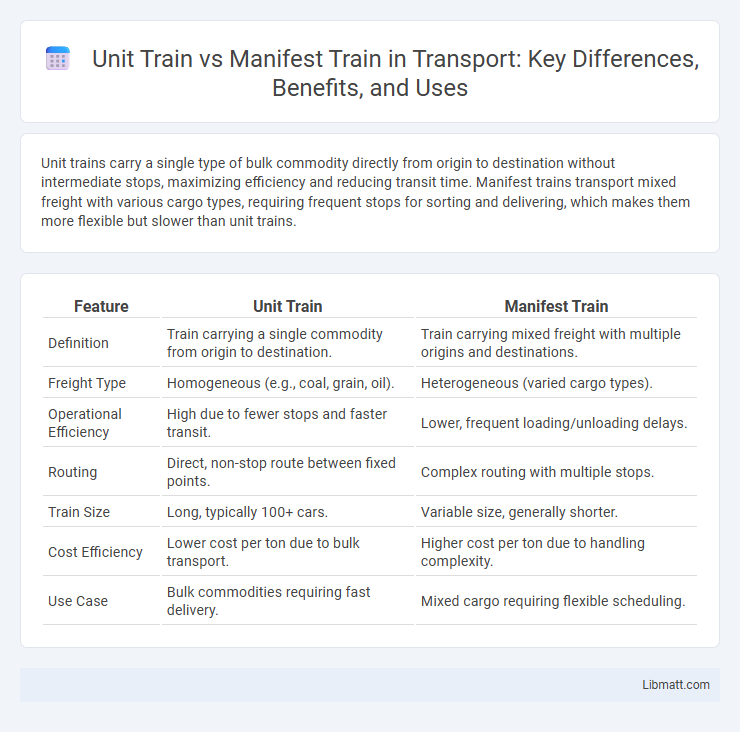Unit trains carry a single type of bulk commodity directly from origin to destination without intermediate stops, maximizing efficiency and reducing transit time. Manifest trains transport mixed freight with various cargo types, requiring frequent stops for sorting and delivering, which makes them more flexible but slower than unit trains.
Table of Comparison
| Feature | Unit Train | Manifest Train |
|---|---|---|
| Definition | Train carrying a single commodity from origin to destination. | Train carrying mixed freight with multiple origins and destinations. |
| Freight Type | Homogeneous (e.g., coal, grain, oil). | Heterogeneous (varied cargo types). |
| Operational Efficiency | High due to fewer stops and faster transit. | Lower, frequent loading/unloading delays. |
| Routing | Direct, non-stop route between fixed points. | Complex routing with multiple stops. |
| Train Size | Long, typically 100+ cars. | Variable size, generally shorter. |
| Cost Efficiency | Lower cost per ton due to bulk transport. | Higher cost per ton due to handling complexity. |
| Use Case | Bulk commodities requiring fast delivery. | Mixed cargo requiring flexible scheduling. |
Overview: Unit Train and Manifest Train Defined
Unit trains consist of a single commodity shipped from one origin to one destination without being split, enabling faster transit times and greater efficiency. Manifest trains transport a variety of freight types with multiple stops for loading and unloading, offering flexibility but longer delivery schedules. Understanding these differences helps optimize your logistics strategy based on cargo type and delivery requirements.
Key Differences Between Unit Trains and Manifest Trains
Unit trains consist of a single commodity shipped directly from origin to destination without intermediate stops, optimizing speed and efficiency for bulk goods like coal or grain. Manifest trains carry mixed freight with multiple cars destined for various locations, allowing flexible routing and shipment consolidation. The key differences include cargo uniformity, operational efficiency, and routing complexity, with unit trains designed for specialized bulk transport and manifest trains suited for diverse freight needs.
Operational Efficiency: Pros and Cons
Unit trains operate with a single commodity and direct route, maximizing operational efficiency by minimizing loading and unloading times and reducing stops compared to manifest trains, which handle multiple cargo types and destinations. Manifest trains offer flexibility for mixed freight needs but face longer transit times and complex logistics, impacting overall schedule reliability. Your choice depends on balancing high-volume, consistent shipments favoring unit trains against diverse cargo requirements better served by manifest trains.
Cargo Types: What Each Train Hauls
Unit trains primarily haul bulk commodities like coal, grain, and minerals, moving large volumes of a single cargo type directly between origin and destination without frequent stops. Manifest trains carry mixed freight, including consumer goods, machinery, and packaged products, making multiple stops to load and unload various cargo types along a route. Your choice between unit and manifest trains depends on the nature of the cargo and shipment requirements.
Scheduling and Flexibility Comparison
Unit trains operate on fixed schedules with dedicated routes, allowing for predictable transit times and optimized efficiency for bulk commodities. Manifest trains offer greater scheduling flexibility by combining diverse freight cars, enabling customized routing and handling multiple destinations on a single journey. This flexibility can lead to variable transit times but ensures tailored services for different shipment requirements.
Cost Implications for Shippers
Unit trains reduce overall shipping costs by transporting a single commodity in bulk, minimizing handling and turnaround times, which leads to lower per-unit expenses. Manifest trains, carrying mixed cargo, involve multiple stops and more complex logistics, increasing operational costs and handling fees for shippers. Cost efficiency for shippers depends on shipment size and commodity type, with unit trains offering optimal savings for large, uniform shipments.
Track Utilization and Network Impact
Unit trains, transporting a single commodity from origin to destination without intermediate stops, optimize track utilization by reducing dwell times and minimizing switching operations, leading to improved network fluidity. Manifest trains handle diverse cargo with multiple pick-up and drop-off points, increasing complexity, track occupancy, and potential delays due to frequent switching and yard operations. The streamlined operation of unit trains significantly lessens network congestion and enhances overall capacity, whereas manifest trains can create bottlenecks impacting scheduling and throughput on shared rail corridors.
Environmental Considerations
Unit trains, transporting a single commodity from origin to destination without intermediate stops, generally produce lower emissions per ton-mile due to higher fuel efficiency and reduced idling times. Manifest trains, carrying mixed freight with frequent stops, result in increased fuel consumption and higher greenhouse gas emissions. Your choice of shipping via unit train can significantly reduce the environmental impact by minimizing energy use and pollutant output.
Use Cases: Industries Best Served
Unit trains excel in bulk industries such as coal, grain, and chemicals, where large volumes of a single commodity are transported efficiently between fixed origin and destination points. Manifest trains serve diverse industries like manufacturing, retail, and automotive by carrying mixed freight with multiple stops for loading and unloading various products. Your logistics strategy benefits from choosing unit trains for specialized bulk commodity shipments and manifest trains for flexible, multi-product distribution needs.
Future Trends in Rail Freight Logistics
Unit trains are expected to dominate future rail freight logistics with their efficiency in transporting large volumes of a single commodity, reducing handling time and operational costs. Manifest trains will continue evolving through advanced digital tracking and scheduling technologies, enhancing flexibility for mixed cargo shipments across diverse supply chains. Your logistics strategy will benefit from integrating these innovations, optimizing rail freight operations for speed and reliability.
unit train vs manifest train Infographic

 libmatt.com
libmatt.com